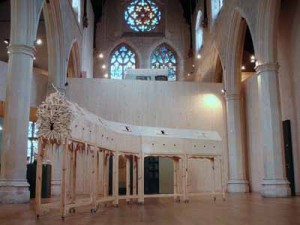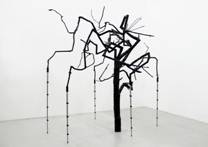
Parabola Presents Andrea Gregson at Garden Museum, Lambeth Palace Road, Andrea Gregson Last Night For Ever, 6-8.30pm, A newly commissioned sculpture for the Garden Museum, London 4th to 27th September 2009www.parabolatrust.org
Andrea Gregson’s sculpture explores the subliminal codes of behaviour hidden in objects and design of manmade spaces. Familiar locations and objects merge together to create unsettling miniature parallel worlds. Her latest work, made for the Garden Museum, comes from a protracted period of research using documents and books found in their archives. The 6m sculpture with architectural details from the Garden Museum, invites the viewer to peer through the different viewpoints revealing a miniature hybrid garden within. In Chinese Gardens by Dorothy Graham, she states that “The idea of a garden was landscape reproduced in miniature”. In this context the sculpture becomes a miniature of a miniature. Gregson describes her use of miniature scale as:
“a critique of our increasingly non-physical life acted out through TV and the internet – people mediating their lives through a screen. Since the miniature space is physically out of bounds, I am interested in the transformative effect on the viewer, from miniature set to psychological trigger of remembered places.”
The sculpture merges layers of imagery from several centuries, and inside, motifs from the former Vauxhall Pleasure Gardens (1661 -1859) and current Spring Gardens, are transformed into a miniature overgrown garden and grotto. It makes connections between past, present and projects into the future, where all the motifs have grown together into a hybrid world. The title of the piece Last Night For Ever, is the name of the closing event at the Vauxhall Pleasure Gardens on 25th June 1859. In one section of the sculpture, we see the present as past, where Spring Gardens, currently the remaining public green from the vast Vauxhall Pleasure Gardens (and a shadow of its former self), is depicted as a sentimental re-creation in the future. The half built blocks of flats become historic ruins, the M16 building looming in the distance, becomes an overgrown mausoleum or garden folly, the horse-riders and animals in the city farm, move across the landscape to add visual interest, as they would have done in 18th century landscaped gardens, and the 21st century hermits who rest on park benches, are the surviving relics from their shell houses and grottoes.
The central box is mirrored to allow the viewer to see into inaccessible spaces and acts as a means to see the reverse of the opposing box, thus revealing the deception of the facades within. Glimpses of other viewers peering in will disrupt the illusion at sporadic moments. This references the original mirrored room at Vauxhall Pleasure Gardens. By standing in the centre of the Rotunda, the viewer would observe multiple images of themselves below motifs of Royal plumage and 16 portrait busts of famous British men of note.
“Signifiers of social station were always at play in Vauxhall’s garden architecture, and were highly unstable: the distinction between Princes, cultural heroes, and the pubic became, in Vauxhall’s hall of mirrors, very difficult to make” (1)
The other side to the sculpture makes reference to Vauxhall Pleasure Gardens and uses some of the visual trickery found within landscape gardens. Both the exterior and the interior of the piece have the sensation of entering a grotto and the entrance appears to be engulfed by a mass of rock-like material. The grotto is a subterranean fantasy recreated throughout history and gains authenticity with its subsequent reproductions. First created in Renaissance Italy as copies of Roman sites of worship, they were later copied in 18th century British Landscape Gardens as sites of fear and wonder, punctuating the garden tours of aristocratic family estates. With each new version of the grotto, the sense of nostalgia heightens, and the greater the loss for all its former guises. At Vauxhall Pleasure Gardens, a large transparency of a hermit could be seen at a distance sitting outside a hut, only on closer inspection would the visitor realise the full deception.
“One is walking into a picture, into a pictorial rendition of the landscape. This illusion whereby the “real” is mediated through representation will feature consistently in the tour through the gardens” (2)
Other motifs in the sculpture reference temples, the Orchestra Stand and ‘The Ruins of Palmyra’ – a large painting placed at the end of an avenue of trees framed by mock Italian arches on the South Walk. This image would have been copied from Robert Wood’s engravings in his illustrated book of 1753, which was used as a primary source for architects and designers as part of the classical revival in Britain. Visitors would be tricked into believing they were real, until the end of the walk where they would be confronted with a painted backdrop rather than reconstructions in stone.
“the eye leads us into a social domain in which visual error, where perception is deception, is the basis for collective empathy: we are part of this socioscopic experience only insofar as we allow our eyes to be deceived.“ (3)
Shells, mixed media and detritus collected from the Thames slipway at Vauxhall will be used as miniature building materials and merge into something more uncanny. Lighting the interior can be adjusted manually and different parts can be seen by peering into the holes and doorways turning the viewer into both stage hand and Peeping Tom. The work tricks the eye and plays with 18th century aesthetics of artifice and excess. Vauxhall Pleasure Gardens were designed within this context and were a pastiche of an aristocratic landscape garden. It was an attempt to represent nature with its ever changing tableaux and garden buildings.
(the)“various elements of the view are understood…in theatrical terms as “screens” or side screens” deployed to direct the viewer’s eye” (4)
The placement of the artwork in the nave of the former St Mary at Lambeth Church (now the Garden Museum) is key to the work, as it reminds us of rituals of life and death. The presence of fake rock gardens, grottos, ruins and temples within the landscape, outlive their makers and are like tombstones – reminding us of someone or something that once was, and now is lost. Nostalgia and a sense of loss is part of the human condition but perhaps could also be a symptom of the advancement of urbanisation – the more green space used for industry and housing, the greater the desire to idealise and mourn the past. The garden is a context in which man controls nature, acts out personal fantasies and within the context of Vauxhall Pleasure Gardens and Spring Gardens, represents real estate and power. The lament below may be written in 1863 but could easily apply to the present :
“Years ago, long before our great-grandparents were born, when the Strand had its gardens, when Holborn could boast of its bees and honey, and when Field Lane, the sink of squalidness, vice and woe, was famed for its Strawberries, laws were passed to stop the further growth of London…….But it availed not, London expanded, swallowing up fields and flowers, trees and meadows, parks and pastures, green lanes and breezy downs …….” (5)
Bibliograhy
1. Pavillions, Power & Patriotism – Garden Architecture at Vauxhall by Gregory Nosan – From Bourgeois & Aristocratic Cultural Encounters in Garden Art 1550–1850 ed. By Michael Conan, 2002
2-4 Vauxhall Gardens:The Visibility of Visuality (ch.2 of ‘The Education of the Eye’ by Peter de Bolla, 2003, Stanford Press)
5. ‘The Parlour Gardener: A Practical Treatise on the House Cultivation of Ornamental Plants’, 1863





